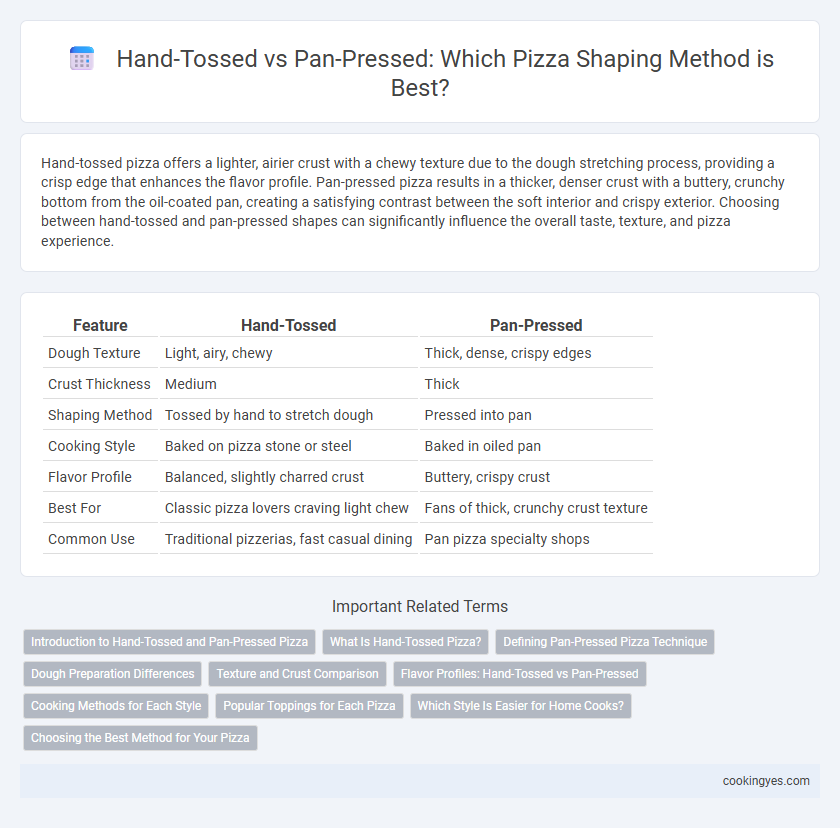Hand-tossed pizza offers a lighter, airier crust with a chewy texture due to the dough stretching process, providing a crisp edge that enhances the flavor profile. Pan-pressed pizza results in a thicker, denser crust with a buttery, crunchy bottom from the oil-coated pan, creating a satisfying contrast between the soft interior and crispy exterior. Choosing between hand-tossed and pan-pressed shapes can significantly influence the overall taste, texture, and pizza experience.
Table of Comparison
| Feature | Hand-Tossed | Pan-Pressed |
|---|---|---|
| Dough Texture | Light, airy, chewy | Thick, dense, crispy edges |
| Crust Thickness | Medium | Thick |
| Shaping Method | Tossed by hand to stretch dough | Pressed into pan |
| Cooking Style | Baked on pizza stone or steel | Baked in oiled pan |
| Flavor Profile | Balanced, slightly charred crust | Buttery, crispy crust |
| Best For | Classic pizza lovers craving light chew | Fans of thick, crunchy crust texture |
| Common Use | Traditional pizzerias, fast casual dining | Pan pizza specialty shops |
Introduction to Hand-Tossed and Pan-Pressed Pizza
Hand-tossed pizza dough is skillfully spun in the air to create a light, airy crust with a slightly chewy texture and uneven, crispy edges. Pan-pressed pizza involves pressing the dough into a pan, resulting in a thicker, golden-brown crust that is crisp on the outside and soft on the inside. Both methods impact dough fermentation and gluten development, influencing the final pizza's taste and mouthfeel.
What Is Hand-Tossed Pizza?
Hand-tossed pizza features a dough stretched and spun by hand, resulting in a light, airy crust with a slightly chewy texture. This method allows for even thickness and a crispy edge, enhancing the overall flavor and bite. Hand-tossed pizza is preferred for its balanced crust that holds toppings well without becoming overly dense or soggy.
Defining Pan-Pressed Pizza Technique
Pan-pressed pizza shaping involves pressing the dough into a deep-dish pan, creating a thick, uniform crust with a crispy edge and airy interior. This technique ensures even cooking by allowing heat to circulate beneath the dough, enhancing texture and flavor compared to hand-tossed styles. It is favored for its consistent shape and ability to hold heavier toppings without collapsing.
Dough Preparation Differences
Hand-tossed pizza dough is stretched by spinning it in the air, creating a thin, airy crust with uneven edges and a chewy texture. Pan-pressed dough is pressed directly into a pan, resulting in a thicker, uniform crust with a crispy exterior and soft interior due to the even heat distribution. The dough hydration level and proofing time vary between methods, with hand-tossed requiring higher hydration for flexibility and pan-pressed favoring a firmer dough for structure.
Texture and Crust Comparison
Hand-tossed pizza dough yields a light, airy texture with a crisp, slightly chewy crust due to its stretched, thin foundation, ensuring even cooking and a classic bite. Pan-pressed pizza dough produces a thicker, denser crust with a buttery, crunchy exterior and soft, doughy interior because it presses into the pan, creating a crispy edge and a tender center. Texture differences stem from hand-tossing incorporating more air and pan-pressing creating uniform thickness for a heartier crust experience.
Flavor Profiles: Hand-Tossed vs Pan-Pressed
Hand-tossed pizza dough produces a lighter, airier crust with a slightly chewy texture that enhances the subtle wheat and yeast flavors. Pan-pressed pizza creates a thicker, crunchier crust with a buttery, caramelized exterior, delivering a richer and more indulgent taste. These distinct crust textures directly influence the overall flavor profile, making hand-tossed ideal for traditional toppings while pan-pressed complements heartier, savory ingredients.
Cooking Methods for Each Style
Hand-tossed pizzas are cooked using high-temperature ovens, allowing the dough to develop a light, airy crust with slight charring. Pan-pressed pizzas rely on baking in a deep-dish style pan, resulting in a thicker, crispier bottom due to oil absorption during the cooking process. Each method affects the texture and cooking time, with hand-tossed requiring a shorter bake and pan-pressed needing longer exposure to heat for even cooking.
Popular Toppings for Each Pizza
Hand-tossed pizzas often feature popular toppings like pepperoni, mushrooms, and green peppers, offering a thinner, crispier crust that balances these ingredients well. Pan-pressed pizzas typically support heavier toppings such as extra cheese, sausage, and olives, with their thicker, airy crust providing a sturdy base. Each shaping method influences the texture and bite, directly affecting how toppings meld with the dough for optimal flavor.
Which Style Is Easier for Home Cooks?
Hand-tossed pizza dough offers more control and traditional texture but requires practice to master spinning techniques, making it slightly challenging for home cooks. Pan-pressed pizza shapes more readily by pressing dough into a pan, ensuring consistent thickness and ease of handling, ideal for beginners. Choosing pan-pressed allows home cooks to achieve a uniform crust with less effort and reduces the likelihood of dough tearing.
Choosing the Best Method for Your Pizza
Hand-tossed pizza dough creates a light, airy crust with a chewy texture due to its stretched, thin shape, ideal for those who prefer a classic Italian pizza experience. Pan-pressed dough produces a thicker, crispier crust with a buttery flavor, perfect for lovers of deep-dish or Sicilian-style pizza. Choose hand-tossed for a traditional, foldable slice or pan-pressed for a hearty, crunchy bite that holds heavy toppings well.
Hand-tossed vs Pan-pressed for pizza shaping Infographic

 cookingyes.com
cookingyes.com